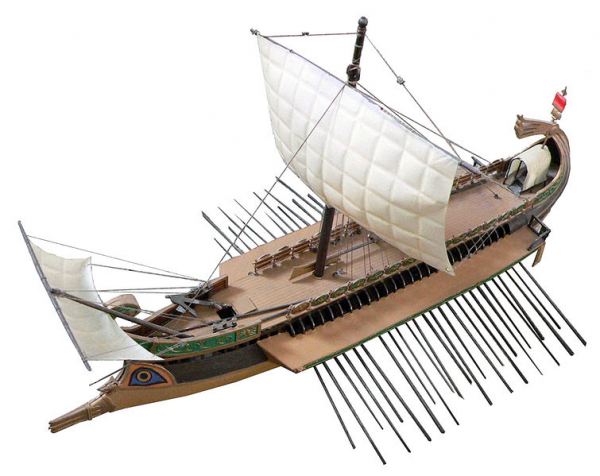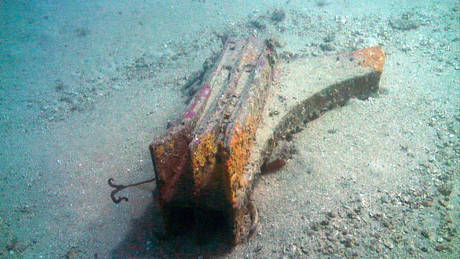Il Rostro Posted by Serena on Nov 18, 2011 in Uncategorized
Rostro: pesante oggetto di sfondamento costituito da un unico pezzo fuso in bronzo montato sott’acqua sulla prua delle navi antiche per affondare le navi nemiche.
Rostro: heavy battering ram made of a single piece cast in bronze which was mounted on the bow of ancient ships below the water line to sink enemy ships.
Above: model of a Roman ship showing the rostro protruding from the bow
On the morning of the 10th March 241 BC one of the greatest and most decisive naval battles in history, la battaglie delle Egadi (the battle of the Egadi), took place to the north west of the island of Levanzo near Sicily. The Carthaginian commander Annone was leading a fleet of 700 ships carrying supplies and reinforcements to the Carthaginian garrison in Sicily, when they were ambushed by a fleet of 350 Roman warships.
According to the Greek writer Polybius, who reconstructed the battle 70 years after the event in his ‘Storie’, the well informed Romans positioned their fleet behind punta di Capogrosso (Capogrosso point) in the extreme north of Levanzo. The Carthaginians, profiting from favourable winds to make a run for Sicily, were taken by surprise by the Romans, who although inferior in numbers were much better armed.
The Roman attack was swift and deadly. They drove the rostri (battering rams) of their fast moving warships into the flanks of their enemies, causing them to sink rapidly. Another technique used was to flank an enemy ship and break all the oars on one side, rendering it unsteerable, and then to assault it with the ‘corvo’, a harpooned catwalk used by the Roman troops to board the enemy vessel.
With the failure of the Carthaginian expedition, the commander in charge of their Sicilian garrison, deprived of provisions and reinforcements, surrendered the island to the Romans. The victorious Roman admiral, Lutazio, returned to Rome a hero.
In June 2008 la Soprintendenza del Mare and the RPM Nautical Foundation discovered a rostro which had been lying on the sea bed for 2,249 years. The rostro belonged to a Roman ship which had sunk during the battle of the Egadi.
Above: a rostro lying on the sea bed at the site of the battle of the Egadi
“Al momento, questo è il quinto rostro esistente al mondo” dichiarava Sebastiano Tusa al momento della scoperta nel 2008, notando la somiglianza con quello già esposto al museo Pepoli di Trapani. La scoperta ha infatti confermato la tesi del Soprintendente Tusa sullo scontro avvenuto fra la flotta romana e cartaginese il 10 marzo 241 a.C. a nord-ovest di Levanzo.”
“At the moment, this is the fifth rostro in the world”, said Sebastiano Tusa at the time of the discovery in 2008, pointing out its resemblance to the one already on display at the museum Pepoli in Trapani. The discovery, in fact, confirmed Superintendent Tusa’s theory about the conflict which took place between the Roman fleet and the Carthaginians on the 10th of March 241 B.C. to the north east of Levanzo”
Since 2008 a total of six rostri have been retrieved, two of which are Carthaginian and four Roman. One of the Carthaginian rostri is inscribed with a Punic script which translates: ”May Baal (the main Carthaginian deity) make this object penetrate the enemy ship”

Build vocabulary, practice pronunciation, and more with Transparent Language Online. Available anytime, anywhere, on any device.






Comments:
Jeannet:
Ciao Serena,
There isn’t much left of the remarkable
‘rostro’ after the 2.249 years! Anyway a thing
to be proud of -to become laying down in the musea.
Saluti,
Jeannet
Joey:
Ciao Serena,
Spero che guarisca presto Sua madre. Mi famiglia ed io ci trasferiremo ad Aviano l’anno prossimo. Sono medico (pediatra) e sto studiando l’italiano. Grazie mille per il Suo blog e le cose che imparo di Lei.
Serena:
@Joey Grazie Joey e buon lavoro ad Aviano.
Saluti da Serena
Jeannet:
Ciao Serena,
Felicamente miei parenti habitano nella Sua
vicinanza diretta.
In bene!
Jeannet
Jeannet:
Salve Serena,
Felicamente i Sua parenti habitano nel Sua vicinanza diretta. Espero per tutti in bene!
Jeannet